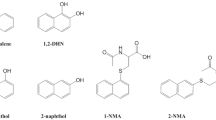Summary
This study was conducted to evaluate the usefulness of three commonly used methods of biological monitoring for worker exposed to methyl ethyl ketone (MEK) under field conditions using blood, breath and urine. Environmental MEK exposures were measured by personal sampling with carbon-felt dosimeters. The correlation coefficient (r) between the time-weighted average (TWA) MEK concentration in air and the MEK concentration in blood collected at the end of the work shift was 0.85. The correlation coefficient between the TWA MEK level in air and the concentration exhaled in the breath of workers at the end of the work shift was 0.71. The end-of-shift urinary MEK excretion correlated best with the environmental concentration (r = 0.89). Correlations became lower after urine samples had been corrected for urinary creatinine (r = 0.83) or specific gravity (r = 0.73). After 8 h exposure to 200 ppm MEK, the corresponding end-of-shift urinary excretion was 5.11μol/l or 4.11 mg/g creatinine. This value is higher than that previously found in some studies, the difference probably being due to the physical acitivites of the present workers and their extensive skin contact with the solvent. The kinetics of inhaled MEK was also studied in eight subjects. Breath and urine samples were collected during the 8-h work shift on 2 consecutive Mondays. The results showed that urinary MEK excretion rose steadily until the end of exposure, whereas the MEK concentration in exhaled air varied markedly throughout the day. These findings suggest that the determination of MEK levels in end-of-shift urine samples appears to be the most reliable biological indicator of occupational exposure.
Similar content being viewed by others
References
American Conference of Governmental Industrial Hygienists (1986) Documentation of the threshold limit values and biological exposure indices, 5th edn. ACGIH, Cincinnati, Ohi
American Conference of Governmental Industrial Hygienists (1990) Threshold limit values and biological exposure induces for 1990. ACGIH, Cincinnati, Ohi
Bernard A, Lauwerys R (1989) Biological monitoring of exposure to industrial chemicals. In: Waldron H (ed) Occupational health practice, 3rd edn. Butterworth, London
Campbell L, Marsh DM, Wilson HK (1987) Towards a biological monitoring strategy for toluene. Ann Occup Hyg 31:121–133
Droz PO, Guillemin MP (1986) Occupational exposure using breath analysis. J Occup Med 28:593–602
Fiserova-Bergerova V, Lowry LK, Rosenberg J (1989) Biological monitoring: II. Measurements in exhaled air. Appl Ind Hyg 4:10–13
Foo SC, Jayaratnam J, Ong CN, Khoo NY, Koh D, Chia SE (1991) Biological monitoring for occupational exposure to toluene. Am Ind Hyg Assoc J 52:212–217
Ghittori S, Imbrani E, Pezzagno G, Capodaglio E (1987) The urinary concentration of solvents as a bilogical indicator of exposure: proposal for the biological equivalent exposure limit for nine solvents. Am Ind Hyg Assoc J 48:786–790
Krasavage WJ, O-Donoghue JL, Divicenzo GD (1982) Ketone. In: Clayton GD, Clayton FE (eds) Patt'ys industrial hygiene and toxicology, vol 2. John Wiley, New York, pp 4777–4790
Liira J, Riihimaki V, Pfaffli P (1988) Kinetics of methyl ethyl ketone in man: absorption, distribution and elimination in inhalation exposure. Int Arch Occup Environ Health 60:195–200
Liira J, Riihimaki V, Engstrom K (1990) Effects of ethanol on the kinetics of methyl ethyl ketone in man. Br J Ind Med 47:325–330
Miyasaka M, Kumai M, Koizumi A, Watanabe T, Kurasako K, Sato K, Ikeda M (1982) Biological monitoring of occupational exposure to methyl ethyl ketone by means of urinalysis of methyl ethyl ketone itself. Int Arch Occup Environ Health 50:131–137
Money CD, Gray CN (1989) Exhaled breath analysis as a measure of workplace exposure to benzene. Ann Occup Hyg 33:257–262
Ong CN, Chia SE, Phoon WH, Tan KT (1991) Biological monitoring of occupational exposure to tetrahydrofuran. Br J Ind Med (in press)
Perbellini L, Faccini GB, Passini F, Cazzoli F, Pistoia S, Rosellini G, Brugnone F (1988) Environmental and occupational exposure to benzene by analysis of breath and blood. Br J Ind Med 45:345–352
Rosenberg J, Fiserova-Bergeroa V, Lowry LK (1989) Biological monitoring: IV. Measurements in urine. Appl Ind Hyg 4:16–20
Sia GL, Ong CN, Chia SE, Phoon WH, Tan KT (1991) Biological and environmental monitoring of methyl ethyl ketone. Environ Monitor Assess (in press)
Tada O, Nakaaki N, Fukabori S (1972) An experimental study on acetone and methyl ethyl ketone concentrations in urine and expired air after exposure to those vapours. J Sci Labour 48:305–336
Teramoto K, Horiguchi S, Kageyama M, Nakasako H, Wakitani F, Adachi M, Yamamoto T (1988) Expiratory elimination of tetrahydrofuran by humans. J Sci Labour 64:54–57
Author information
Authors and Affiliations
Rights and permissions
About this article
Cite this article
Ong, C.N., Sia, G.L., Ong, H.Y. et al. Biological monitoring of occupational exposure to methyl ethyl ketone. Int. Arch Occup Environ Heath 63, 319–324 (1991). https://doi.org/10.1007/BF00381581
Received:
Accepted:
Issue Date:
DOI: https://doi.org/10.1007/BF00381581




